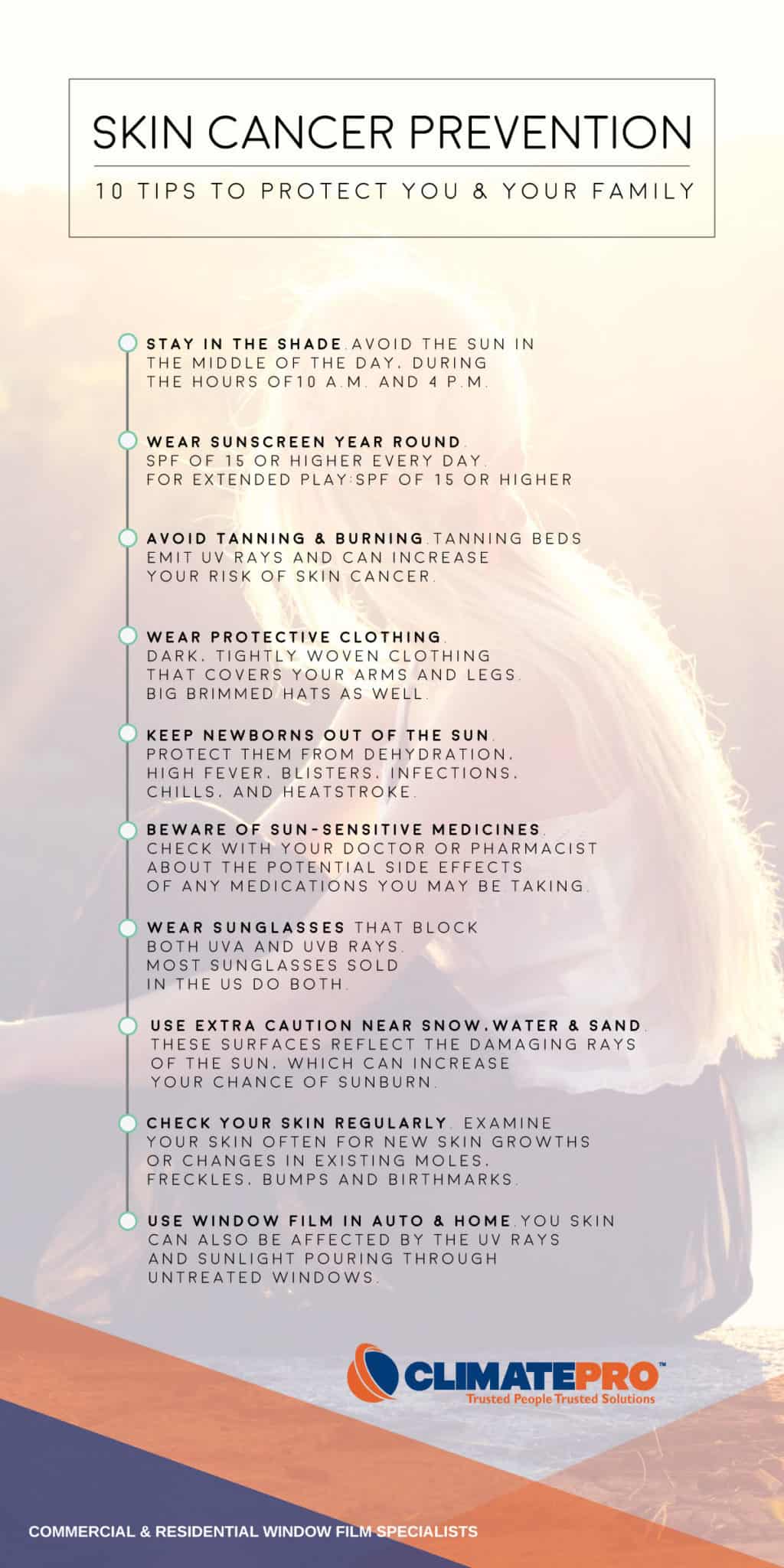
The ClimatePro team makes it our aim to stay abreast of the latest news and information that directly affects our San Francisco Bay Area customers. One topic that we pay keen attention it is the issue of skin cancer. Recently updated research provides some startling statistics. The American Academy of Dermatology reports that current estimates suggest that 1 in 5 Americans will be diagnosed with skin cancer in their lifetime. They also note that for 2015, “it is estimated that one in 50 Americans will develop melanoma in their lifetime. These are staggering figures and they highlight how important it is to take skin cancer prevention seriously.
What is skin cancer?
According to the Center For Disease Control, “skin cancer is the most common form of cancer in the United States. The two most common types of skin cancer—basal cell and squamous cell carcinomas—are highly curable, but can be disfiguring and costly. Melanoma, the third most common skin cancer, is more dangerous and causes the most deaths. The majority of these three types of skin cancer are caused by exposure to ultraviolet (UV) light”.
Here are some facts about melanoma, from the National Council on Skin Cancer Prevention:
- By 2015, it is estimated that one in 50 Americans will develop melanoma in their lifetime.
- Rates for new melanoma cases have been rising on average 2.6% each year over the last 10 years. It is the 5th leading cause of cancer in the U.S.
- Melanoma is more common in men than women and among individuals of fair complexion and those who have been exposed to natural or artificial sunlight (such as tanning beds) over long periods of time.
- There are more new cases among Caucasians than any other racial/ethnic group.
- Melanoma rates are highest among ages 55-64 years.
- Melanoma is expected to be diagnosed in about 76,690 persons in 2013, accounting for less than 5% of all skin cancer cases but the vast majority of skin cancer deaths.
- Among young adults between 20-39 years, melanoma is the second most common invasive cancer, behind only breast cancer.
- Until the age of 40, females have a higher incidence of melanoma than males, with a peak ratio of 1.8:1 (female:male) occurring between 20 and 24 years of age. After age 40, this ratio reverses, and older men had twice the incidence of older females.
- The estimated cost of treating melanoma in 2010 was $2.36 billion.
Certainly, with these facts in mind, it makes sense to give skin cancer serious thought. Even in the San Francisco Bay Area, where many areas experience cloudy days, the threat of developing skin cancer from over exposure to UV rays is real. See this real-life experience for proof.

What is UV radiation?
UV radiation, as we’ve discussed on the ClimatePro blog before, is the invisible radiation that comes from the sun, tanning beds and heat lamps. UV rays come in 3 forms: ultraviolet A (UVA), ultraviolet B (UVB), and ultraviolet C (UVC). UVC is absorbed by the ozone layer, so never reached the earth’s surface. UVB rays are also absorbed by the ozone layer, but it also helps to produce vitamin D in the skin. It don’t reach as far into the skin as UVA rays, but they still can be damaging to humans.
UVA rays are unique in that it is the most common kind of sunlight to reach the earth’s surface. It also reaches beyond the top layer of human skin and hence, according to the CDC, “scientists believe that UVA rays can damage connective tissue and increase a person’s risk of skin cancer”. It’s understandable that these are the rays to be most concerned about.
Did you know that the Environmental Protection Agency (EPA), along with the National Weather Service have developed an index that forecasts the risks of UV exposure. This handy index is a great tool to assist you as you protect yourself and your family while you work and play. With all the information available, it has been conclusively noted that most skin cancers are avoidable, if we follow a few suggestions diligently.

Skin Cancer Prevention Tips
With that in mind, here are 10 tips to help you protect yourself and your family from skin cancer.
- Stay in the shade. According to the National Council on Skin Cancer Prevention, you should especially avoid the sun in the middle of the day, during the hours of10 a.m. and 4 p.m.
- Wear sunscreen year round. The Skin Cancer Foundation suggests using “a broad spectrum (UVA/UVB) sunscreen with an SPF of 15 or higher every day. For extended outdoor activity, use a water-resistant, broad spectrum (UVA/UVB) sunscreen with an SPF of 30 or higher”. SPF stands for ‘Sun Protection Factor’.
- Don’t burn or tan. This includes both natural sun tanning and artificial tanning, like tanning beds and lamps. The Mayo Clinic notes that the “lights used in tanning beds emit UV rays and can increase your risk of skin cancer”. The more you learn about tanning beds, the more you’ll want to stay away from them. When you read some of these facts, the realization that tanning beds are a real danger becomes clear.
- Wear protective clothing. The truth is, sunscreens don’t provide complete protection from UV rays. You’ll still need to cover your skin with dark, tightly woven clothing that covers your arms and legs. As for hats, a broad-brimmed hat, is better for sun protection than a baseball cap or visor. There are even companies that sell photo-protective clothing.
- Keep newborns out of the sun. The Skin Cancer Foundation reminds us that while sunburns are dangerous for adults, they can cause a medical emergency for infants. The dangers include dehydration, high fever, blisters, infections, chills, and heatstroke. Also, sun damage in infants can vastly increasing their lifetime skin cancer risk.
- Beware of sun-sensitive medicines. File this under the ‘don’t forget to check with your doctor’ category. Did you know that some common prescription and over-the-counter drugs, including antibiotics, can make your skin more sensitive to sunlight? It’s always wise to check with your doctor or pharmacist about the potential side effects of any medications you may be taking. If they increase your sensitivity to sunlight, taking extra precautions to stay out of the sun is a wise course.
- Wear sunglasses. You’ll want to wear sunglasses that block both UVA and UVB rays. Most sunglasses sold in the US do both. Wrap around sunglasses are you best protection. They may not be the most stylish solution, the the coverage the offer may be worth the sartorial disadvantage is nothing compared to losing your eyesight.
- Use extra caution near water, snow, and sand. This may not be something we think about often, but these surfaces reflect the damaging rays of the sun, which can increase your chance of sunburn.
- Check your skin and report any changes to your doctor. The Mayo Clinic suggests that we examine our skin often for new skin growths or changes in existing moles, freckles, bumps and birthmarks. By using a mirrors, be sure to check your face, neck, ears and scalp. Examine your chest and trunk, and the tops and undersides of your arms and hands, the front and back of your legs, and your feet, including the soles and the spaces between your toes. Also check your genital area and between your buttocks. Parents will want to do the same for their children.
- Use window film. Not only will you want to have protective window film for your automobile, you’ll definitely want to have window film installed professionally at home. Just as you’ve probably seen carpet and furniture damaged by the sun, you skin can also be affected by the UV rays and sunlight pouring through untreated windows. You ClimatePro team is fully versed in the latest window films that are designed to protect your skin both at work and at home.

Resources:
- Skin Cancer Prevention Tips. The National Council on Skin Cancer Prevention.
- Prevention Guidelines. Skin Cancer Foundation.
- Skin Cancer Facts. Skin Cancer Foundation.
- Skin Cancer Prevention. Center for Disease Control.
- Sun Safety. Center for Disease Control.
- What Can I do to reduce my Risk of Skin Cancer? Center for Disease Control.
- Skin Cancer. Mayo Clinic.
- What is SPF? About.com
- Sun Protection for Infants. Center for Disease Control
- Window Film: Sun Protection for Health and Home. Skin Cancer Foundation.
- Sun Protection in the Snow. Northern Ireland Cancer Focus.




